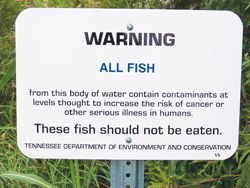Persistent, Bioaccumulative and Toxic Chemicals (PBTs)
Chemicals that are persistent in the environment, bioaccumulate in people and/or wildlife, and are toxic are called PBTs. Because of these features, as long as they remain in commerce and may therefore be released into the environment, they will threaten the health of humans and wildlife. The nature of the risk will depend on their specific toxic properties, the size of the exposed population or ecosystem, and the extent and duration of exposure. But, because of their persistence and ability to bioaccumulate, once exposure levels are sufficient to cause adverse effects in humans, domestic animals, or wildlife, their impacts are not easily reversed.
Then, even if their production and use are discontinued, many years may pass before their concentrations have sufficiently declined so that they no longer pose risks. Because of this combination of properties, the government should take immediate action to phase PBTs out of commerce.
Properties of PBTs
Persistence
 In the environment, many chemicals are degraded by sunlight, destroyed through reactions with other environmental substances, or metabolized by naturally occurring bacteria. Some chemicals, however, have features than enable them to resist environmental degradation. They are classified as “persistent”and can accumulate in soil and aquatic environments.1 Those that can evaporate into air (volatilize) or dissolve in water can migrate considerable distances from where they are released. Humans, domestic animals, and wildlife are more likely to be exposed to a chemical if it does not easily degrade or is dispersed widely in the environment. The structural characteristics that enable a chemical to persist in the environment can also help it to resist metabolic breakdown in people or wildlife. For example, synthetic chemicals that contain halogen atoms (particularly fluorine, chlorine, or bromine) are often resistant to degradation in the environment or within organisms.
In the environment, many chemicals are degraded by sunlight, destroyed through reactions with other environmental substances, or metabolized by naturally occurring bacteria. Some chemicals, however, have features than enable them to resist environmental degradation. They are classified as “persistent”and can accumulate in soil and aquatic environments.1 Those that can evaporate into air (volatilize) or dissolve in water can migrate considerable distances from where they are released. Humans, domestic animals, and wildlife are more likely to be exposed to a chemical if it does not easily degrade or is dispersed widely in the environment. The structural characteristics that enable a chemical to persist in the environment can also help it to resist metabolic breakdown in people or wildlife. For example, synthetic chemicals that contain halogen atoms (particularly fluorine, chlorine, or bromine) are often resistant to degradation in the environment or within organisms.
Metals, such as lead, mercury, and arsenic, are always persistent, since they are basic elements and cannot be further broken down and destroyed in the environment. Although this discussion will focus on synthetic organic chemicals the potential health effects of exposure to metals should not be overlooked.2 For example, lead contamination of air, soil, or drinking water can ultimately result in significant exposures in fetuses, infants, and children, resulting in impaired brain development.
Bioaccumulation
Chemicals that accumulate in living organisms, so that their concentrations in body tissues continue to increase, are called bioaccumulative. In fish and other aquatic organisms, bioaccumulation is sometimes called bioconcentration. The bioconcentration factor (BCF) is an expression of the extent to which the concentration of a chemical in a fish is higher than the concentration in the surrounding water. Very low concentrations of a bioaccumulative substance in water can result in markedly higher concentrations in the tissue of fish at higher levels of the aquatic food chain, as well as in people or wildlife eating those fish. Concentrations of airborne bioaccumulative chemicals will also be magnified in air-breathing organisms.3
 To a large extent, the potential for a chemical to bioaccumulate can be predicted by examining whether the chemical preferentially dissolves in an organic solvent as opposed to water.4 If the concentration of a chemical in the solvent is more than 1000 times higher than its concentration in water when added to a mixture of solvent and water5, the chemical is likely to bioaccumulate in organisms. If that concentration gradient is >5000, the chemical is highly likely to bioaccumulate.
To a large extent, the potential for a chemical to bioaccumulate can be predicted by examining whether the chemical preferentially dissolves in an organic solvent as opposed to water.4 If the concentration of a chemical in the solvent is more than 1000 times higher than its concentration in water when added to a mixture of solvent and water5, the chemical is likely to bioaccumulate in organisms. If that concentration gradient is >5000, the chemical is highly likely to bioaccumulate.
Many bioaccumulative chemicals are fat-soluble so that they tend to reside primarily in fat deposits or in the fatty substances in blood. This explains why fat-soluble bioaccumulative chemicals are often found at elevated levels in fat-rich breast milk.6 But bioaccumulative substances may also be deposited elsewhere, including bone, muscle, or the brain.
Toxicity
Chemicals can have a variety of toxic properties, resulting in a diverse array of adverse health effects. According to the EPA, the toxicity rating of a potential PBT chemical is based on repeated exposures which result in human or environmental toxicity. Adverse impacts can include mutagenic damage to DNA, cancer, neurological toxicity, reproductive toxicity, developmental toxicity, or immune system damage, among others.
(EPA’s criteria for PBTs are available at http://www.pbtprofiler. net/criteria.asp)
Examples
A partial list of known PBTs includes: anthracene, asbestos, cadmium and cadmium compounds chloroalkanes, C10-13 (short-chain chlorinated paraffins), p-Dichlorobenzene, hexabromobiphenyl, hexabromocyclododecane, hexachlorobutadiene, lead and lead compounds, mercury and mercury compounds, musk xylene, pentachlorobenzene, perfluorooctane sulfonic acid, perfluorooctane sulfonyl fluoride, phenanthrene, polybrominated biphenyls, polybrominated diphenylethers (PBDEs), polychlorinated terphenyls, tetrabromobisphenol A, 1,2,3-Trichlorobenzene, 1,2,4-Trichlorobenzene, 1,2,3,4- Tetrachlorobenzene, and 1,2,4,5-Tetrachlorobenzene.
Many polychlorinated biphenyls (PCBs) are also PBTs. These chemicals were phased out of commerce in the late 1970s because they are persistent, bioaccumulative, and increase the risk of cancer. Since then, we have learned that PCBs also interfere with normal brain development in children. However, because they are persistent and bioaccumulative, most people in the US still have detectable levels of PCBs in their blood although levels are gradually declining.
Brominated flame retardants
 For many years, chemicals belonging to a family of brominated flame retardants (BFRs) have been added to plastics, foam, and fabrics to impart flame resistance. Unfortunately, they are not chemically bound to the material and have escaped into the general environment where they resist degradation and have entered the food chain, resulting in widespread exposure in virtually all people. Concentrations of several BFRs in blood and breast milk in people in the US are nearly 10 times higher than in Europe.
For many years, chemicals belonging to a family of brominated flame retardants (BFRs) have been added to plastics, foam, and fabrics to impart flame resistance. Unfortunately, they are not chemically bound to the material and have escaped into the general environment where they resist degradation and have entered the food chain, resulting in widespread exposure in virtually all people. Concentrations of several BFRs in blood and breast milk in people in the US are nearly 10 times higher than in Europe.
Animal studies show that certain BFRs known as polybrominated diphenyl ethers (PBDEs) can interfere with normal brain development and function, and can cause other adverse health effects. Recently, a scientific study confirmed these findings in people. PBDE levels were measured in a large group of pregnant women during pregnancy and at the time of birth. Compared to the lowest exposure group, the children who were exposed to the highest levels of PBDEs prenatally performed worse on virtually every test of neurological function during the first six years of their lives. Ongoing studies will be necessary to determine if these impacts are permanent, as they are in animal tests. Meanwhile, even if PBDEs were removed from commerce today and replaced with safer alternatives, their concentrations would fall very slowly since most are persistent and bioaccumulative, as well as toxic.
PFAS Forever Chemicals
Many PFAS (per- and polyfluoroalkyl substances) are also PBTs. This is a diverse family of chemicals comprised of carbon chains of various lengths fully loaded with fluorine atoms. They have numerous uses. They impart stain and water resistance in carpets, fabrics, and other materials, create non-stick surfaces in cookware and are used as surfactants, and in hydraulic fluids, among other applications. PFAS are highly persistent in the environment and, according to studies conducted by the CDC, several PFAS are present in the blood of virtually everyone in the general population. They also bioaccumulate in people and wildlife.
 In animal studies, PFAS can cause developmental disorders, liver toxicity, immune system problems, and tumors. Studies in people are limited. Several show that higher levels of two PFAS correlate with higher cholesterol levels and a higher incidence of thyroid disease. (CDC) Additional human studies are underway. Because of ubiquitous exposures to PFAS, their persistence, ability to bioaccumulate, and toxicity, replacement with safer alternatives is urgently needed.
In animal studies, PFAS can cause developmental disorders, liver toxicity, immune system problems, and tumors. Studies in people are limited. Several show that higher levels of two PFAS correlate with higher cholesterol levels and a higher incidence of thyroid disease. (CDC) Additional human studies are underway. Because of ubiquitous exposures to PFAS, their persistence, ability to bioaccumulate, and toxicity, replacement with safer alternatives is urgently needed.
Take Action


Endnotes:
- Persistence is usually described as the half-life (T ½) of a chemical in water, soil, sediment, or air. The T ½ is the amount of time necessary for a given amount of chemical released into the environment to decrease to one-half of its initial value. For example, if 30 grams of a chemical with a T ½ of 6 months were released into a lake and settled into the sediment, 15 grams would still be present in 6 months and 15 grams would have been degraded into various by-products. Six months later (one year since the original release), 7.5 grams of the original amount would still be present. And so on.
- Organic chemicals are usually defined as those containing carbon atoms although the distinction between organic and inorganic chemicals is somewhat arbitrary.
- Food chains or food webs represent predator-prey relationships in ecosystems. For example, small fish may eat insects or other small aquatic organisms. In turn, small fish are eaten by larger fish and so on. Birds or mammals that eat fish will consume any and all of the persistent contaminants previously eaten by the fish.
- In a mixture of oil and water, some chemicals dissolve in the oil more readily than water and vice versa. Similarly, some chemicals preferentially dissolve in the solvent, octanol, more readily than in water.
- This is called the octanol-water coefficient.
- Despite the presence of PBTs in breast milk, breast feeding is superior to formula feeding and is strongly supported by extensive evidence.
